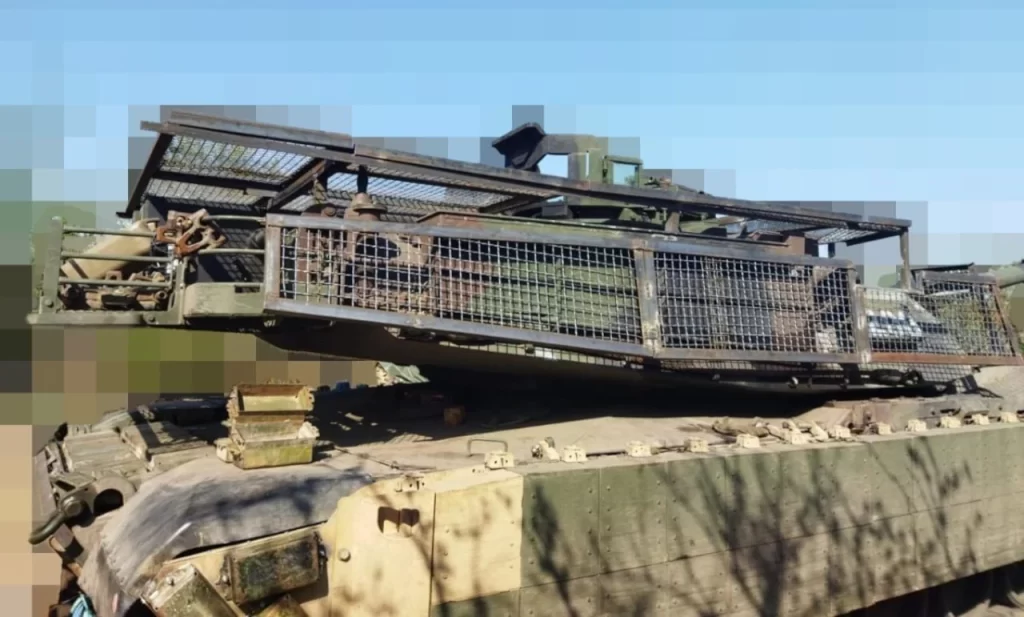At the onset of the Ukraine war, Russian tanks implemented anti-drone grids, which were ridiculed for their resemblance to chicken coops. The laughs ceased as the Russian tanks started to influence the battlefield significantly. The grids protected the tanks against weaponry that targeted them from above. Currently, the Ukrainians have implemented these grids to protect the tanks that Western supporters provided.
The Ukrainian army has taken measures to ensure that the American-made M1A1 “Abrams” main battle tanks, which were previously vulnerable to damage, are now properly outfitted and protected. Relevant photographs reveal the presence of new standardized anti-drone grid armor on the turret, American standard reactive armor kits on both sides of the vehicle, and Soviet-developed “Kontakt-1” explosive reactive armor on the front of the vehicle. Furthermore, other parts of the tank have also been modified to different extents to improve their defensive qualities.
Based on publicly accessible information, sources indicate that out of the 31 M1A1 tanks supplied by the U.S. to Ukraine, a minimum of eight have been verified as destroyed, damaged, or left behind. Furthermore, the Russian military went as far as to transport one back to Moscow to exhibit it to the public. Initially, these tanks of American origin were sent to the Ukrainian battlefield without any supplementary armor, unlike other tanks from Western countries. Additionally, they lacked any equipment specifically designed to counter drone threats. Consequently, they were systematically destroyed by a range of Russian weapons, including unmanned aerial vehicles (UAV), anti-tank missiles, and high-caliber projectiles. Subsequently, the Ukrainian military installed “Kontakt-1” explosive reactive armor, originally developed during the Soviet era, onto the frontal section of the M1A1 tank hull and other Western tanks.
Nevertheless, when confronted by the first-person view (FPV), suicide drones (UAVs), and other UAVs, these countermeasures demonstrated only a limited level of efficacy. About one month ago, U.S. authorities disclosed that the Ukrainian military had strategically removed M1A1 main battle tanks from the front lines to prevent more losses of these expensive American-manufactured tanks. U.S. officials expressed their concern about the extensive deployment of drones in the Russia-Ukraine conflict, stating that the presence of these UAVs made it impossible for tanks to operate openly without the risk of being spotted.
FPV suicide drones are characterized by their exceptional maneuverability and are equipped with shaped-charge armor-piercing warheads. These warheads explode upon impact with a target, making them a common danger in the Russia-Ukraine military conflict. Presently, the menace presented by FPV suicide drones on the battlefield is akin to that of artillery.
Ukraine news reports say the country has commenced the installation of standardized anti-drone grid armor on M1A1 tanks. These armors are specifically engineered to trigger the explosive warheads of anti-tank rockets mounted on FPV drones before they reach their intended target. They are inexpensive, easy to maintain, and simple to install, making them suitable for large-scale manufacture. On May 24th, the Ukrainian steel and mining giant unveiled its latest innovation, the grid armor. FPV drones, due to their exceptional maneuverability and the expertise of their operators, can execute offensive maneuvers by exploiting the limited openings in grid armor and other defensive mechanisms. As a result, these grid armors need to be tailored to fit various tank models, which, to a certain degree, adds complexity to their construction and installation.
The company asserts that, by conducting a collaborative study with military engineers on the regions commonly subjected to attacks by FPV suicide drones and the exposed positions requiring safeguarding, they verified the necessity of implementing supplementary protective structures for various tanks. All drawings of supplementary armor systems consider each tank type’s design characteristics and special conditions, as the additional armor must not only protect against external threats but also avoid restricting its operation or complicating the equipment. It must function effectively in battle situations without causing any disruption to the ongoing combat operations. The combined weight of this supplementary armor system can reach a maximum of 430 kg.

Based on the photographs, it is clear that the M1A1 tanks are fitted with anti-drone grid armor that provides extensive coverage. This armor effectively safeguards the entire tank turret, including the top, front, sides, and rear doors. The vehicle’s engine compartment, located near the rear, is safeguarded by grid armor to defend against any attacks. Furthermore, the M1A1 tanks are outfitted with the American standard M19 Reactive Armor Tiles (ARAT) on both sides of the hull. Additionally, the front and sides of the hull are equipped with the Soviet-designed “Kontakt-1” explosive reactive armor.
The company has announced that it is equipping the Ukrainian army’s operational Soviet-era T-64 and T-72 series tanks with standardized anti-drone armor. The Ukrainian army has received more than 25 sets of additional armor systems following extensive testing, with seven sets allocated for M1A1 main battle tanks. Nevertheless, the true operational effectiveness of these enhanced M1A1 tanks remains uncertain.
